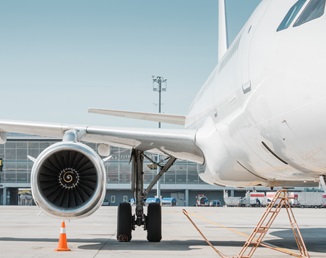
Cirium Ascend Consultancy is trusted by clients across the aviation industry to provide accurate, timely, and insightful aircraft appraisals. The team provides the valuations and analysis the industry relies on to understand the market outlook, evaluate risks and identify opportunities.
Discover the team’s industry reports & market commentaries. Read their latest expert analysis, viewpoints and updates on Thought Cloud.

Eleni Maragkou, Valuations Analyst, Cirium Ascend Consultancy
The offshore oil & gas (O&G) helicopter market presents the industry with more opportunities for replacement rather than growth in the next decade. The emphasis is predicted to be on newer designs with better economics and payload/range, according to the Cirium Helicopter Forecast and discussion at the latest Cirium webinar, Helicopter Offshore 2024. The panel provided perspectives on market dynamics and the future outlook, from industry experts comprising Bristow senior vice-president key accounts Samantha Willenbacher, Lider Aviacao chief executive Junia Hermont, and Cirium Ascend Consultancy lead appraiser helicopters and AAM Sara Dhariwal. The event was moderated by Cirium Ascend Consultancy head of consultancy operations Chris Wills, a senior ISTAT appraiser.
In summary:
- The ratio of the operational O&G helicopter fleet to the number of oil rigs decreased from a high of 1.1 in 2016 to 0.8 in 2024.
- The in-service offshore configured fleet has contracted by around 25% from the peak in 2014.
- Preference is shifting towards the cabin and range combinations of medium and super medium aircraft sizes.
- The Cirium Helicopter Fleet Forecast predicts limited growth, with 90% of the 400 new deliveries forecast in the next 10 years to be replacements and a compound annual growth rate (CAGR) of just 0.3%.
- Petrobras in Brazil is increasing activity, with an investment of $102 billion forecast during 2024-2028, while new bids for 2026-2027 are expected to add 50 aircraft.
Sara Dhariwal noted that the proportion of operational helicopters relative to the number of active oil rigs has reduced from a high of 1.1 in 2016 to 0.8 today. It indicates that there has been a reduction in the significant surplus that existed following the O&G downturn. The reduction is due both to a recovery and increase in active oil rigs, and the fact that the in-service offshore configured fleet has contracted by around 25% since the peak in 2014.


There is a shift in preference away from single engine and light/intermediate twins, towards the larger cabin and longer-range combination of the medium twin and super medium aircraft sizes. The Cirium Helicopter Forecast predicts that this trend is likely to persist in the next decade, driven by various factors including a move away from the heavy size due to limited replacement opportunity.
Right sizing remains a key factor for the industry and helicopter values, with the past decade seeing both under- and over-capacity. The implications of this trend were also discussed, based on the future of the offshore market, with a need to adapt to changing market dynamics and for operators to invest in the right size of helicopters to meet demand and customer needs. Diversification of the fleet is key to mitigating supply-orientated risks.


In the higher capacity helicopter categories, there is evidence that the super mediums, including the AW189 and the H175, are gaining more market share from the main heavy type, the Sikorsky S-92A.
Competition in this size category is about to become even greater with the entry of the Bell 525 Relentless. During HAI HeliExpo 2024, Norwegian oil major Equinor announced a commitment for 10 Bell 525s, which is the first major order for the type.
Deliveries are scheduled to begin in 2026. The increasing competition in this size category reflects the preference for helicopters with greater capacity and range, catering to the evolving needs of offshore operations. The Cirium Helicopter Fleet Forecast suggests that the trend is likely to continue into the next decade, driven by technology and changes in operational requirements.
Age can be challenging if their age limit comes midway through a contract…
Samantha Willenbacher, Senior Vice-president Key Accounts at Bristow
Bristow’s Willenbacher commented: “Age can be challenging if their age limit comes midway through a contract… the older AW139s, short nose with TCAS 1 and we are seeing this a lot in Brazil which is switching more to requiring TCAS 2. That is a proportion of the AW139 fleet that is going to need to find a part of the world where these aircraft can operate. Customer requirements are shifting.”
In terms of values, the Rotorcraft Aircraft Market Sentiment Index (RAMSI) by Cirium Ascend Consultancy focused on the offshore sector and indicated a positive trajectory for most in-production types operating in the sector with values trending upwards. The exception is the S-92A, where there appears to be some uncertainty, as it currently faces issues with a shortage of MRO and spares capacity.


The Cirium Helicopter Fleet Forecast anticipates the focus to be on the replacement of around one-quarter of the current fleet, meaning that 90% of the forecast 400 new deliveries in the next 10 years will be replacements, and a CAGR of just 0.3%.
The majority of the deliveries are predicted to be of newer designs with better economics and payload and range. The new medium sized Airbus H160 and super medium Bell 525 will be the latest types entering the offshore market. The forecast is for around 40% of deliveries to be of medium and super medium types, with the combined category anticipated to increase its share to 50% by 2032.
The challenges in the O&G support industry include the importance of long-term contracts to drive investment confidence and encourage growth and stability in the sector.
Petrobras contracts have only five years, so in order to invest in new helicopters, we need to have long-term contracts
Junia Hermont, Chief Executive at Lider Aviacao
The Cirium Helicopter Fleet Forecast anticipates limited growth over the next decade, driven by emerging markets. Challenges such as equipment diversification, contract terms and an aging fleet remain key considerations for operators. The emergence of new technologies such as manned and unmanned vertical take-off and landing aircraft (VTOLs), could present development opportunities for the industry but requires careful navigation through certification processes and operational adjustments.
In conclusion, the offshore helicopter market presents both challenges and opportunities while seeing signs of recovery. By understanding the market dynamics, fostering confidence and embracing technological advancements, key industry players can navigate the evolving landscape and capitalise on recovery prospects in the years to come.
FOR MORE INFORMATION, CONTACT US. Watch the webinar, Helicopter Offshore 2024, on demand now.


























































